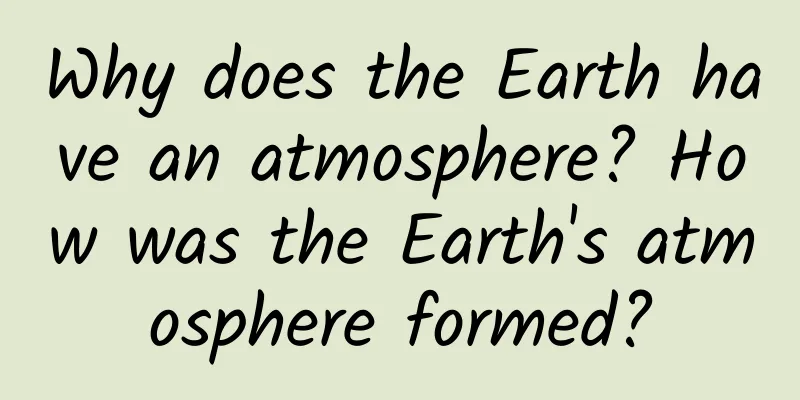Why does the Earth have an atmosphere? How was the Earth's atmosphere formed?

|
Produced by: Science Popularization China Author: Talking about the world Producer: China Science Expo The atmosphere on which human beings depend for survival is a huge gaseous layer surrounding the entire earth, called the atmosphere. The atmosphere is transparent, colorless, tasteless and odorless when it is not polluted. This layer of atmosphere is composed of many kinds of gases, among which the oxygen contained is the most important for human survival. This layer of atmosphere is in constant motion. The wind we feel is a manifestation of air movement. This layer of air can transmit sound waves, helping humans communicate. The existence of this layer of atmosphere can also prevent radiation harmful to human health from entering the environment where humans live, protecting humans' normal life and reproduction. In short, this layer of atmosphere is very important for the progress of mankind and society. (Photo source: veer photo gallery) The atmosphere also attracts people with its unpredictable charm. A long time ago, people have been very interested in this confusing world of the atmosphere. In particular, they are most concerned about its "origin". How was the atmosphere born? What was the original atmosphere like? Is it the same as today's atmosphere? This series of questions has been debated to this day. It is generally acknowledged that the Earth's atmosphere evolved into what it is today after millions of years of continuous renewal during the Earth's formation. But how did it evolve? It is generally believed that the evolution of the Earth's atmosphere can be divided into three stages. Primitive atmosphere stage About 5 billion years ago, the atmosphere mysteriously "came into being" along with the birth of the Earth. That is, when the nebula mentioned by Laplace began to condense, a large amount of gas was already surrounding the Earth. The main components of the original atmosphere were hydrogen and helium. After the Earth was formed, the decay of radioactive substances inside the Earth caused energy conversion. This conversion played a role in the maintenance and disappearance of the Earth's atmosphere. Coupled with the strong effect of the solar wind and the small gravity of the Earth when it was just formed, the original atmosphere disappeared quickly. Secondary atmosphere stage After the Earth was formed, the temperature dropped, condensation occurred on the Earth's surface, and the high temperature inside the Earth prompted frequent volcanic activity. The volatile gases formed during volcanic eruptions gradually replaced the original atmosphere and became the secondary atmosphere. The main components of the secondary atmosphere are some gases with relatively heavy molecular weights, such as carbon dioxide, methane, nitrogen, hydrogen sulfide and ammonia. These gases and the solid matter of the Earth attract each other and are interdependent. Today's atmospheric phase As solar radiation develops in depth on the earth's surface, the strong photosynthesis of ultraviolet rays with relatively short light waves generates oxygen in the earth's secondary atmosphere, and the amount of oxygen continues to increase. With oxygen, it provides an extremely favorable "hotbed" for the emergence of life on earth. After billions of years of decomposition, assimilation and evolution, life was finally born in the cradle of the earth. The primitive single-cell life, in the "cradle" woven by the atmosphere, has continuously evolved and evolved, and finally developed into the advanced human beings who dominate world civilization today. In this process, today's atmosphere has also gained such a "happy family". (Photo source: veer photo gallery) Although today's atmosphere is a mixture of various gases, the main component is nitrogen, followed by oxygen, and there are some other gases, but the amount is extremely small. The reason why today's atmosphere is formed in this way is the result of the long-term evolution of the earth. How did today's atmospheric composition come to be? There are two main views on why the composition of today's atmosphere is what it is and how it evolved over a long period of time. One view is that today's atmosphere evolved from the original atmosphere of the Earth. Another view is that the original atmosphere no longer exists, and the current atmosphere evolved from the substances ejected by volcanic activity inside the Earth. To analyze and explain this issue, we can compare it with the Earth's neighbors (Venus and Mars). According to exploration data, the atmospheric composition of Venus is mainly carbonic acid gas, and its lower part is mainly carbon dioxide, and there are also small amounts of oxygen, nitrogen, carbon, neon, helium, and water vapor, and atomic oxygen in the upper part. The atmospheric composition of Mars is mainly carbon dioxide, and there are also some ammonia, hydrogen, oxygen, water vapor and other substances. So was the atmosphere like this in the past? As a question, you can consider it this way. If the original atmosphere of the earth was also mainly composed of carbon dioxide, then why is it different from today's nitrogen and oxygen? If the earth's atmosphere is mainly from volcanic eruptions, according to the current data of volcanic eruptions, the volcanic eruption materials are mainly water vapor, accounting for 81%, carbon dioxide accounting for 10%, and there are also nitrogen, sulfur, etc., but no free oxygen. Therefore, it can be seen that these components are very rare, whether from the original atmosphere or from the volcanic eruption gas. Moreover, since there is free oxygen in the atmosphere, ozone can be formed. With oxygen, carbon monoxide in the original atmosphere is oxidized into carbon dioxide, methane is oxidized into water vapor and carbon dioxide, and ammonia is oxidized into water vapor and nitrogen, so carbon dioxide is dominant. (Photo source: veer photo gallery) Carbon dioxide accounts for a large proportion of the initial atmosphere, but due to the development of photosynthesis, a large amount of carbon is used to form organisms, and another part of the carbon is dissolved in the ocean and becomes a substance for the development of marine organisms. When there is more carbon dioxide in the atmosphere, the amount of carbon dioxide dissolved in the seawater is relatively more. There is now a view that the concentration of carbon dioxide is increasing due to the burning of fossil fuels. However, as the concentration of carbon dioxide increases, the result of the ecological balance in nature cannot cause the concentration of carbon dioxide to increase excessively, and a part of it must be dissolved in the water. Another component is nitrogen. The main component of the atmosphere is nitrogen, but judging from the original atmosphere or volcanic eruption gas, the nitrogen content is very small, only a few percent. There are two main reasons for the increase in nitrogen. First, the chemical properties of nitrogen are very inactive and it is not easy to combine with other substances. It mostly exists in a free state. On the other hand, the solubility of nitrogen in water is very low, which is only one-seventh of that of carbon dioxide. Therefore, it mostly exists in the atmosphere in a free state. Due to the reduction of carbon dioxide, most of the initial water vapor has turned into liquid water, becoming today's hydrosphere. Relatively speaking, the ratio of nitrogen to oxygen has increased. Therefore, there is so much nitrogen today, which is related to the characteristics of nitrogen itself. Of course, nitrogen also circulates. Some rhizobia can absorb nitrogen, allowing part of it to participate in the biological cycle. After these substances decay and decompose, they release free nitrogen; a small part of nitrogen also enters the nitrate in the earth's crust. Although nitrogen participates in the cycle, most of it exists in a free state. Relatively speaking, its amount is increasing, and it has become the main component of the atmosphere. (Photo source: veer photo gallery) From this we can draw two conclusions: First, the current atmospheric composition is the result of the long-term evolution of the earth and the result of a full material cycle with the hydrosphere, biosphere, and lithosphere. It can be said that these spheres are interconnected and mutually penetrating as a whole. Second, the current atmospheric composition is still in a continuous cycle, and this process is basically balanced and stable, and will not change significantly in a short period of time. |
<<: The "Sky Catcher" Builders on the 4,400-meter Plateau
Recommend
How to convert the raw and cooked weights of food? The weights of food recommended by the New Dietary Pagoda are all raw weights.
On April 26, the long-awaited 2022 edition of the...
The most popular way of Internet promotion nowadays!
We have sorted out seventeen popular Internet pro...
A brief discussion on the rules of Kuaishou live streaming
Amid the epidemic, offline stores are bound to be...
2020 Zhihu promotion and traffic generation skills!
Choice is greater than effort? No comment. I don’...
Xinzhu "30-day hand-painting training camp: Become a hand-painting master even with zero basics"
Xinzhu's "30-Day Hand-Painting Training ...
How to play with Tik Tok splash screen ads? Here’s a set of “Douyin” marketing techniques for you!
There is no doubt that TikTok has become a social...
New battery technology emerges: iPhone battery life is expected to increase by 3 times
What is your wish for the new generation of iPhone...
If you miss these words on the packaging, half of the things in your kitchen may need to be thrown away!
If a lot of food is not placed in the right place...
Constellation navigation, flyby exploration, a new round of lunar exploration begins, and new trends gradually emerge
Recently, China, the United States, Russia, the E...
iPhone X will be criticized, but it will still be popular | On 4P and brand
The iPhone is criticized every year, so why does ...
Energy conservation without loss? Is South Korea's discovery of "room temperature superconductivity" reliable this time?
A team of physicists from South Korea recently up...
How much does it cost to make a dance school mini program in Qinzhou?
How much does it cost to make a dance school mini...
How deep learning is bringing personalization to the internet
[[195601]] Deep learning is a subset of machine l...
Following WeChat, QQ and 59 other apps: Google and Apple's Indian app stores will remove Baidu and Weibo
According to the Times of India, the Indian gover...
How to write a good article title for WeChat public account?
There is no doubt that the title of an article is...









